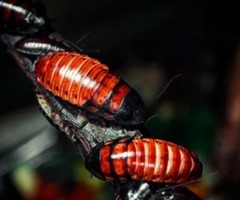
What is the lifecycle of a cockroach, and why should you care? Well, every living organism goes through a series of developmental stages during its lifetime. The cockroach is no different. A little knowledge here can give you a better understanding of what’s going on in and around your property. You’re then in a better position to treat an invasion before it gets out of control.
The Developmental Stages of a Cockroach
Roaches go through three distinct developmental stages of life:
- Roach egg
- Roach nymph
- Roach Adult
Roach colors vary during its lifecycle. Most of the eggs are some shade of brown. The young nymphs tend to be a grayish-brown color across most of the species. Adults can be reddish-brown, dark brown, or even black, again, depending on the species. How a roach develops is also influenced by where it lives and its environment, i.e., temperature and moisture levels.
Lifespan of a Cockroach
The lifespan of a roach is often measured in days rather than years. How long they live varies, depending on the species and conditions during each phase. The table below gives a rough comparison between America’s two most common pests.
Now let’s look at the developmental stages of a cockroach in more detail. It’s a generalization as there are too many species to cover, but it gives you a good insight nonetheless.
Luring an Unwilling Mate
Most female cockroaches are oviparous. That means they lay eggs, so the young have no embryonic development inside the mother. Roach mating starts with the male luring the female into an exact position. He must bait her first as she doesn’t come willingly. The male does this by secreting an irresistible sugary-rich substance from his abdominal gland.
The female moves the sperm into a special package or spermatophore during the mating ritual. The spermatophore also carries vital nutrients for the female roach and her new eggs.
Stage 1 | Cockroach Eggs
The female German roach typically lays one egg batch every six weeks give or take. For the American species, it’s once or twice a month. All females produce a hard or leathery protective egg case called an ootheca. Mom carries the ootheca around on the tip of her abdomen for a few hours or a number of days. She eventually rests the ootheca in a hidden location and adheres it to a surface using saliva.
Roaches that infest homes keep their oothecae in dark, out-of-the-way cracks and crevices. It takes four weeks or more for the small eggs to hatch and the nymphs to emerge.
Stage 2 | Cockroach Nymphs
Roach eggs hatch between 24–48+ days in ideal conditions, depending on the species. The newborn nymphs begin life as vulnerable, soft white insects. They grow in stages via a shedding process called metamorphosis. Its form becomes more adult-like with each molting of the exoskeleton or external skeleton. This shedding process happens 10+ times before the roach becomes a fully grown adult.
The period between each molt is an instar, and it varies a lot between the species. You can see the nymphal development period for American and German roaches in the table above.
Stage 3 | The Adult Cockroach
A nymph reaches adulthood after its final molt. It’s also developed 3 pairs of long legs on the thorax, and two pairs of wings. On its head are two fully matured antennas divided into three distinct sections, i.e., the scape, pedicel, and flagellum. The insect’s size and life expectancy depends on the species. The adults are now equipped with reproductive capabilities, and so the life cycle continues.
A Day in the Life of an Adult Cockroach
An adult roach doesn’t do much more than reproduce, rest, and scavenge for food. It’s inactive during daylight and comes out at around four hours after sunset. Roaches don’t sleep in the traditional sense. Instead, they follow a circadian rhythm or internal clock that includes a rest period. On the face of it, the life of a cockroach seems meaningless, but it’s anything but wasted.
Roaches are not futile. They are detritus feeders and break down a lot of what other organisms leave behind. That, in turn, helps to increase nitrogen in the soil. They’re also a vital part of the food chain for other animals like birds, mammals, and reptiles.

Leave a Reply